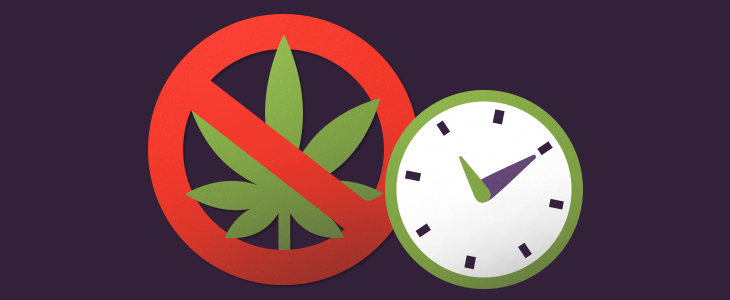Tolerance breaks are when you give your body a hiatus from using cannabis. Although there is no scientific evidence to define how long this break should last, it has been shown that taking some time off can be beneficial in resetting cannabinoid receptors. Keep reading for tips on tolerance breaks from a doctor.
Although “tolerance breaks” may initially make people think of taking a break from smoking weed recreationally, T-breaks can actually benefit anyone who consumes cannabis on a regular basis.
The goal when using cannabis for medicinal, health or wellness purposes is to find the perfect amount that helps optimise your body’s homeostasis or balance. However, what constitutes as the “right amount” varies amongst individuals and depends on various factors such as tolerance level. Tolerance levels may also change over time due to your body becoming accustomed to certain cannabinoids.
In short, a tolerance break is refraining from using THC products or medications for a set time frame. Some people suggest taking one week off while others recommend one month.
Even though research has not yet pinpointed an exact time limit, a study from 2015 concluded that after 48 hours, cannabinoid receptors have already started the reset process. Therefore, it is commonly believed that taking a tolerance break for at least 48 hours is ideal.
For long-time cannabis users or those taking high doses of THC, it may take longer to restore optimal endocannabinoid functioning.
It’s important to find a balance between self-care and symptom control when you’re treating a chronic illness with medical cannabis. People who use CBD-only products or mostly CBD products usually don’t need a T-break (tolerance break). Keep in mind that you can develop a tolerance to both THC and specific strains of cannabis over time.
How cannabis works on your body
There are over 400 research-backed chemicals in cannabis, and of those, CBD and THC are the best known. These two cannabinoids vary widely in how they affect the human body.
When we take CBD, it interacts with various enzymes and receptors in our body to help modulate things like pain, anxiety and inflammation. Although it does help increase the activity of our own internal cannabinoids (endocannabinoids), it doesn’t directly stimulate the CB1 or CB2 receptors.
THC is a agonist (stimulator) on the CB1 and CB2 receptors, similar to our body’s natural cannabinoid, Anandamide. However, because THC directly affects those receptors, an excess of THC can hinder their functioning. Consequently, you may need some time away from using it.
You don’t need to take a tolerance break from CBD because it doesn’t interact with your endocannabinoid receptors or ECS.

The importance of tolerance breaks
The ECS is a crucial system for keeping your body performing optimally. It regulates functions such as sleep, pain, stress, digestion and more. Having a healthy ECS is key to maintaining good overall health.
Most chronic diseases are caused by a deficiency in the endocannabinoid system, which is responsible for various functions in the body. This is called clinical endocannabinoid deficiency. CBD and THC can both be beneficial in improving the function of theendocannabinoid system.
However, since THC affects cannabinoid receptors directly, it can reduce the number of cannabinoids your body produces. As a result, using THC properly is key to maintaining optimal ECS function. Tolerance breaks can be helpful in resetting the system for better functionality.
What is a cannabis tolerance break?
A tolerance break is when somebody abstains from consuming THC-based cannabis products or medications for a set period of time. Although there is no scientific research that provides an ideal duration for a tolerance break, it’s widely accepted that 48 hours (or more) is sufficient. This belief comes from a study published in 2015 which found that endocannabinoid receptors start to reset after just 48 hours.
Signs you may need a tolerance break
More cannabis is not always better.
The main indication that a medical cannabis patient may need a tolerance break is when they feel as though their symptom control results are declining while consuming the same dose of medication. If patients find themselves increasing their THC dosage to achieve previous effects, it likely means they are building up a tolerance to THC.
For those consuming cannabis for adult use purposes, you’ll likely see an increase in consumption with limited increase in your desired result (ie. relaxation or feeling uplifted). However, if you are using it medicinally, results may be more significant.
It’s worth emphasizing that, in terms of THC, less is not always more. With how THC works with the human body and its receptors, too much of it may actually have negative consequences on both your physicality as well as your ability to function properly.
How to take a tolerance break
If you are taking medicinal cannabis prescribed by a doctor, it is important to remember that you should only do a tolerance break with guidance from your physician. It is also crucial to remind individuals who are taking CBD only cannabis that tolerance breaks don’t apply to them.
Abstaining from THC
Before you start your tolerance break, it’s best to plan ahead. Some people feel withdrawal symptoms when they quit THC cold turkey, so it’s important to be aware of your body and health during the process. We recommend taking a T-break on the weekend or when you have some free time so that you can focus on your recovery.
To do a tolerance break, simply choose a start and end date. During that time, avoid taking any THC-containing cannabis products.
Restarting your THC products
The 48-hour break is only the beginning. Afterward, you’ll want to cut your doses in half from what was previously an effective therapeutic dose.
“You’ll still be undertreated if you reduce your dosage by half. After cutting down to 50% of what you originally took, go up slowly and carefully. From the reduced amount, take a bit more each day or with each dose. Be aware of how this affects you physically and mentally.”
By following this process, you will be able to return to your original dosage, or even a lower dose, and still reap the benefits.
An example:
For example, if someone who was taking five milligrams of THC at night to treat their symptoms finds that it’s no longer effective, I might recommend a tolerance break instead. After 48 hours have passed, they can start up again at two milligrams per night. We might then increase the dosage by one milligram each day until they reach three milligrams. At this point,they may start to experience some benefits. And then with any luck, upon reaching four mg will notice relief similar to what they were previously experiencing.”

Tips for taking a tolerance break
Take CBD during tolerance breaks
If you’re alternating between taking a CBD isolate and THC products, it’s essential to keep up with your CBD intake during the break. You might also want to chat with your doctor about possibly boosting your CBD dose for a little while. Higher levels of cannabidiol may help alleviate some of the symptoms that you’ve been treating with THC-based products.
Do things that naturally upregulate your ECS
Furthermore, now is an ideal opportunity to bolster your ECS through additional natural methods. For instance, you might consider meditation, yoga or other exercises that you find enjoyable. Also, eating healthily and getting enough sleep during this time may enable your ECS to reset more rapidly. Additionally, it’s best to avoid anything that promotes inflammation such as alcohol and tobacco products.
Tolerance to strains of cannabis
If you find that you’re not getting the same benefits from your CBD after taking a break and titrating back up, it’s possible that you’ve built up a tolerance to the particular strain or formulation.
If you’re experiencing this issue as a patient, it’s important to speak with your doctor about changing formulas to a different but similar product.
Conclusion
A tolerance break is when you take a temporary hiatus from consuming cannabinoids so that your body can reset its sensitivity to them. If you feel like you’re no longer getting the same relief or benefit from cannabis as you used to, it may be time for a tolerance break.
T-breaks may be beneficial for medical cannabis patients, but it is important that you speak with your doctor first to weigh the pros and cons. If treating a chronic condition, make sure to have the support of those around you before beginning the break period. This way, you can avoid any potential relapses in your condition or symptoms.

